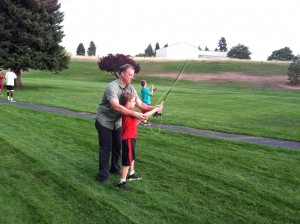By Jule Shultz, Riverkeeper Technical Lead
A few months ago, while scouting locations for water quality sampling sites, we came across this shallow stream that was recently dredged by a landowner. The ditch, excavated for the purpose of draining agricultural land, flows directly into Hangman Creek bringing with it: • High water flows unfiltered by streamside vegetation • Tons of sediment • Fertilizer • Fecal Coliform (from feces and manure) • And other nasties!
Hangman Creek has been documented as one of the most polluted waterways in Washington State
(WRIA, 2005; Stream Report, 2005).
But why should you care about the health
of Hangman Creek?
- Do you like swimming or recreating in the Creek or Spokane River? High levels of fecal coliform in Hangman Creek pose a health hazard to those who come into contact with it. Improving waste water treatment plants and implementing proper animal management practices are key to cleaning the creek.
- Do you enjoy fly fishing for native trout? High temperatures in Hangman Creek kill native redband trout and impede their reintroduction. Soil erosion destroys spawning beds and kills the insects that trout need to eat. Streamside shorelines vegetated with trees and shrubs that create a canopy lower water temperatures and provide habitat for insects that trout need to survive.
- Do you love the rolling farmland of the Palouse? Poor farmland management washes tons of that dirt, and the associated nutrients, into Hangman Creek every year. This sediment and nutrients fuel toxic algae blooms in Long Lake, creating health warnings and unsightly algal mats. “Direct seed” methods of agriculture could reduce agricultural runoff dramatically.
We sent this photo and others to local regulatory agencies, thinking that surely this must be illegal. Although I’m not a lawyer, I felt there must be some law broken when a stream can just be dredged and straightened. As it turns out, these actions are perfectly legal based on a number of agricultural exemptions to the Clean Water Act
As someone who cares about the health of the Spokane River, and who diligently monitors pollution on this stream, this allowable exemption which results in severe pollution in our watersheds is beyond frustrating. Given the lack of regulation on agricultural lands how does one clean up these sources of pollution? Some programs are being implemented, for instance in the Chesapeake Bay and the Great Lakes. However, in many cases these programs rely heavily on incentives, such as through grants and loans for proper pasture management. Relying solely on incentives, without a regulatory backstop, allows bad actors to continue polluting without any penalty.
Locally a number of organizations are working towards cleaning up Hangman Creek. Riparian plantings, land and easement purchases, and implementation of conservation practices all work towards the goal of clean water in Hangman Creek. However, I think the problem is so big in this watershed none of these practices alone will solve it.
So what is the solution? The answer to that will be complex. It will involve providing incentives to implement best management practices, regulation of existing water quality law and education about the value of intact riparian buffers. The Spokane Riverkeeper will be working in the Hangman watershed for years to come. We will be exploring pollution solutions through monitoring water quality, pressing for the enforcement of existing regulations, educating the public and advocating for a swimmable and fishable river.
Despite the legality of the pollution shown above, there are many ways to make a difference on Hangman Creek. Reporting pollution as it is happening, volunteering with one of the many organizations, such as the Spokane Riverkeeper, and supporting your local environmental group all go a long way towards restoring Hangman Creek.


